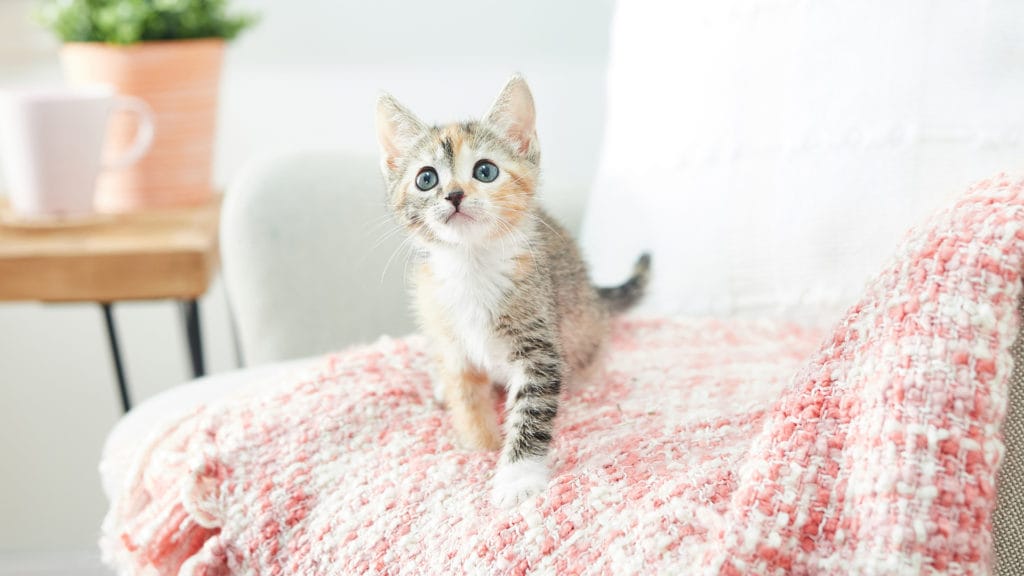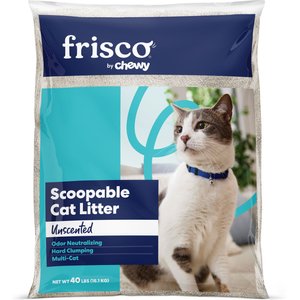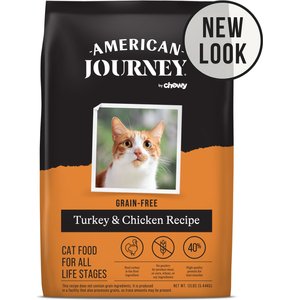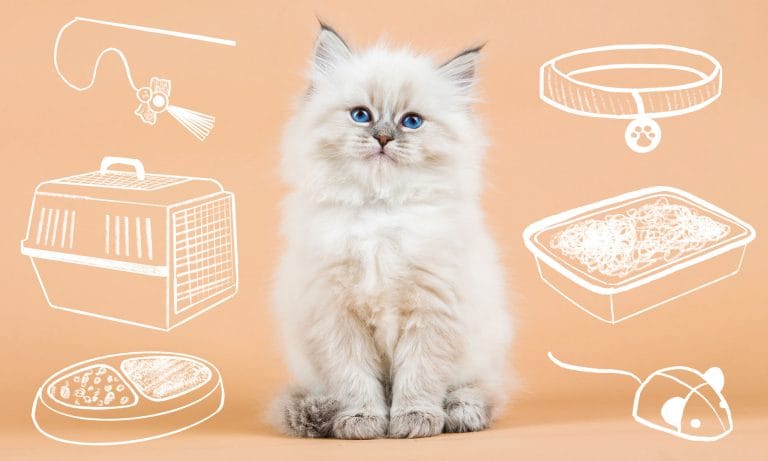Getting a new cat? Congratulations! Few things in this world are as soothing as the steady hum of a cat purr. And who doesn’t love getting slow blinks from their feline friend (that means “I Love You” in cat).
While getting a new cat brings joy, it’s important to remember that there will be a transition period, which can be difficult for new furry family members.
Dr. Sandra Mitchell, owner of All Creatures Veterinary Services in Bangor, Maine, recommends keeping your cat in a separate room, like the bathroom, with all the basic cat supplies she’ll need so she has time to adjust to her new environment.
“Moving into a new household can be very stressful, especially for mature cats,” Dr. Mitchell says. “Starting them off in one small area for the first day or two makes the transition less overwhelming.”
This is especially important if you have other pets in the household.
“I do NOT recommend introducing them cold turkey,” she says. “Most cats adjust better if the cats are kept separated and allowed to slowly get used to each other over 4-6 weeks.”
As you welcome your cat into her new home, be sure to provide her with the right pet supplies to help ensure an easy transition. Here are the essentials to have on hand.
Cat Supplies for the First 36 Hours
- Cat Food – Preferably you’ll be able to get the same brand your new cat is used to eating to prevent tummy upsets. You can always work on transitioning her to a different food later.
- Food and Water Bowls – Your kitty will need her own bowl for mealtime, and make sure she stays hydrated with one or more water bowls.
- Collar and ID Tag – These are essential for identifying your cat in case she gets lost. Even if you have an indoor-only kitty, you should get your cat an ID tag in case she escapes. Cats are stealthy and can slip out of the house undetected. Make sure her tag has your cat’s name and your current contact information.
- Cat Litter – There are a variety of litters available, from clay to corn-based. Cats tend to prefer scent-free, dust-free clumping litter, according to Dr. Mitchell, but you’ll have to see what works best for your cat.
- Cat Litter Box and Scoop – The general rule is one litter box per cat, plus one extra.
- Cat Trees or Scratchers – These give your cat an appropriate place to condition her claws. A cat tree also provides your cat with an appropriate place to climb (aka not the kitchen counter).
- Cat Toys – She’ll need these for mental and physical exercise.
- Cat Bed – This will help your cat feel conformable in her new home.
- Calming Aids – Help ease the transition for nervous or older cats with products like cat calming collars or sprays infused with pheromones.
- Cat Carrier – You might think you can improvise, but you’ll need a cat carrier to keep your cat safe and contained for trips to the vet.
Those are the basics for a cat of any age. As time goes on and you get to know your new family member better, you can tailor the supplies to meet her specific needs and preferences.
You’ll also need to provide additional items and care specific to her life stage.
Long-Term Essentials for Specific Life Stages
Kitten
For this young stage, the focus is on exposing your kitten to new things, helping her grow mentally and physically, and encouraging good behaviors. Below is an assortment of cat supplies to help your kitten develop into a healthy, happy adult cat.
- Hunting Toys – Wands, lasers and other toys can be chased and hunted down, which can help provide kittens with mental stimulation and exercise.
- Flea and Tick Control – Talk to your vet to find out which type of product is best for your kitten.
- Grooming Supplies – Be sure to maintain your kitten’s coat. Essential must-haves include a brush (Dr. Mitchell recommends daily brushings) and nail trimmers (for weekly trimmings).
- Dental Products – Pick up a toothbrush and toothpaste to get your kitten used to having her teeth cleaned early on.
- Nail Caps – These are great to use if furniture scratching is a problem (trimming your kitten’s nails also will help).
- Catnip – You can use catnip to encourage your kitten to scratch on her scratcher or cat tree. Many older kittens and cats love catnip.
- Stain and Odor Remover – These are formulated specifically to clean up pet messes, which might happen while your kitten is learning to use the litter box.
“To keep kittens happy and healthy I recommend keeping them as indoor-only pets,” Dr. Mitchell says. “It is much safer and with some creativity, they can still live very enriched lives.“
There are plenty of ways to get creative and provide your kitten with a source of entertainment. Window-mounted bird feeders, for example, are great for bird-watching and sunbathing.
“I also recommend feeding a canned food only diet, making sure they have their kitten exams and vaccines, testing them at their first veterinary visit for feline leukemia and feline immunodeficiency virus, and having them spayed or neutered at a young age,” Dr. Mitchell says.
Your kitten’s needs will change as she develops into an adult cat.
View and download our New Kitten Checklist.
Adult Cat
For this more mature stage, focus on products that help create enriching environments to keep cats mentally and physically fit.
- Cat Shelves – Your cat can survey her kingdom from up high (and snooze out of reach from others).
- Window Perch – This provides a cozy place to lie and watch birds and other wildlife.
- Grooming Products – These will be used for daily coat brushing and weekly nail trimmings.
- Dental Products – Have a toothbrush and toothpaste on hand to prevent dental disease.
- Nail Caps – Keep these on hand if furniture scratching is a problem (trimming your cat’s nails will also help).
- Catnip – Many cats go wild for catnip.
- Flea and Tick Control – Talk to your vet to find out which type of product is best suited for your cat.
- Stain and Odor Remover – You’ll need these to clean up pet messes, like hairballs.
Adult cats, as with cats in any life stage, should be tested for FeLV (feline leukemia virus) and FIV (feline immunodeficiency virus) before or immediately after adoption, Dr. Mitchell says.
As cats get older and become seniors, it’s important to provide them with supplies that will help support their changing needs.
Senior Cat
In general, senior cats benefit from products that accommodate physical changes that arise with aging. Look for products like these that can help make their environment more comfortable and easier to navigate.
- Low-Profile Litter Box – Older cats often have mobility issues that make getting in and out of the litter box difficult.
- Cat Steps or Ramps – These can help mobility-impaired pets get up onto furniture.
- Supplements – Ask your veterinarian for recommendations for hip and joint support.
- Heated and Orthopedic Pet Beds – Provide maximum support and comfort for achy joints.
- Catnip – This feline favorite encourages playtime and scratching in old age.
- Flea and Tick Control – Talk to your vet to find out which type of product is best suited for your cat.
- Grooming Products – Elderly cats tend not be as good at self-grooming as when they were younger.
- Dental Products – Use a cat toothbrush and toothpaste to prevent dental disease. Cats become more prone to dental disease as they age.
- Stain and Odor Remover – You’ll need to clean up accidents when senior cats can’t make it to the litter box.
One of the best things you can do to keep your senior kitty happy and healthy is to schedule regular veterinary checkups. This includes “complete laboratory panels to help identify changes early so they can be addressed before they become problems,” says Dr. Mitchell.
And don’t forget to give your golden oldie lots of love and attention.
“Older cats benefit from pampering and extra TLC—and often appreciate it!” Dr. Mitchell says.
By: Stephanie Brown, BeChewy Senior Editor
Featured Image: By Chewy Studios
Share:














